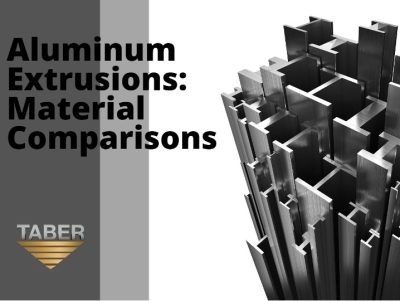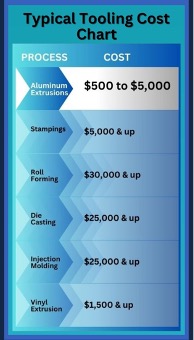Aluminum Extrusions: Material Comparisons

Aluminum extrusions offer many advantages when material comparisons are considered. Aluminum extrusions have revolutionized the way our world is built today, offering the ability to create complex shapes with precision and outperforming alternative materials such as wood, plastic, steel, and other metals. Construction, transportation, military, aerospace, and consumer goods are just a few of the applications for which engineers and designers now turn to aluminum extrusions as the standard.
When designing aluminum extrusions, you must take into consideration aluminum alloys and the specific application requirements, including load-bearing capacity, structural integrity, and functionality. Selecting the right alloy and surface treatment becomes vital — considering the intended environment, such as temperature variations and exposure to corrosive elements. Designers must also optimize shape and geometry — minimizing material waste and ensuring easy fabrication or assembly after the extrusion process.
Addressing these factors early on unlocks the full potential of aluminum extrusions, creating visually appealing, highly functional, cost-effective sustainable products. As Steve Jobs once said, “Design is not just what it looks like and feels like. Design is how it works!”
Tooling Cost and Lead Time

Source: Aluminum Extruders Council (AEC)
Tooling costs and lead times are critical factors in the aluminum extrusion process and other manufacturing methods. Tooling refers to the creation of molds, dies, and other specialized equipment required for a manufacturing process, while lead time refers to the time required for tooling preparation, production setup, and the completion of a production run. Properly considering these factors is crucial for achieving efficient production, controlling costs, and meeting project timelines.
Aluminum alloys offer distinct advantages here, simplifying the fabrication of tooling components due to their unique properties: easier machinability, lower melting point, reduced wear on tools, superior thermal conductivity, lighter weight, corrosion resistance, abundant availability, and overall efficiency in manufacturing processes. Steel, on the other hand, demands more complex and time-consuming tooling processes due to its melting point and more intricate machining requirements.

Source: Aluminum Extruders Council (AEC)
Extrusion: A Brief Comparison Between Materials
Extrusions revolutionized manufacturing, enabling precise, complex shape creation, heightened efficiency, and versatility across materials like plastics, wood, and metals such as aluminum, steel, and copper. With a wide range of materials available, form and function must go hand in hand, and a great designer, engineer, or builder understands the value of knowing and choosing the right tools and materials for a successful build. Here are brief material comparisons.
Among these materials, aluminum, and aluminum alloys offer several advantages over alternative materials. Its properties provide a compelling combination of strength-to-weight ratio, corrosion resistance, formability, electrical and thermal conductivity, sustainability, and energy efficiency. When compared to roll-formed steel, aluminum extrusion provides similar strength with significantly reduced weight, making it a preferred choice for applications that require structural integrity while prioritizing weight reduction.
Copper extrusions, although strong —are much denser than aluminum, resulting in lower strength-to-weight ratios. Molded plastic materials, while lightweight, generally have lower strength and thermal conductivity compared to aluminum.
Although it is a natural and versatile material, wood is not as strong or lightweight as aluminum. Vinyl extrusions, on the other hand, are resistant to corrosion —but lack the strength and thermal conductivity of aluminum.
With the necessity of sustainable products, aluminum is the perfect choice. Known as the “Green Metal,” aluminum is one of the most environmentally friendly metals and can be recycled infinitely.
Overall, aluminum extrusion offers a more compelling set of properties that make it the preferred choice for various applications when compared to alternative materials utilized in the extrusion process.

Source: Aluminum Extruders Council (AEC)
To dive more into the comparison of materials in the extrusion process and see how aluminum extrusion is clearly the best option for your build, you can also check out the American Extrusion Council (AEC) website.
Taber Extrusions is proud to work with the American Extrusion Council (AEC) in providing information about aluminum extrusion and its flourishing industry.
More About Taber Extrusions
Taber Extrusions, located in Russellville, AR and Gulfport, MS, is a highly regarded provider of aluminum extrusions to various industries, including aerospace, infrastructure, transportation, defense, and thermal management.
ISO 9001 and AS 9100 certified, Taber’s present and future customers can expect increased supply opportunities with the expanded set of extrusion solutions, programs, and services.
Founded in 1973, Taber Extrusions originally pioneered a process for extruding rectangular billet, which enables the company to extrude solid profiles up to 31 inches wide or hollows up to 29 inches. Taber expanded with the purchase of an extrusion facility in Gulfport, MS in 1995, which houses a new state-of-the-art cast house and two additional presses. Micro-extrusion capabilities and the fabrication area have been expanded multiple times. We continue to extrude billet in a wide range of alloys and sizes. We have diversified our markets beyond the military since our inception to include aerospace, automotive, marine, infrastructure, and sporting goods, among many others.
Our company supplies cast and extruded products in various soft and hard alloys for these markets.
Today, Taber Extrusions is proud of its friction stir welding capabilities and a complete offering of extruded aluminum components, value-added machining services, and raw material supply to the North American market.
Thank you for your continued support of Taber Extrusions, LLC. If you have any questions, please visit taberextrusions.com or contact one of our Regional Sales Representatives.
Follow Taber Extrusions:
LINKEDIN: https://www.linkedin.com/company/taberextrusions/
FACEBOOK: https://www.facebook.com/taberextrusions/
TWITTER: https://twitter.com/taberextrusions
Interested in becoming a part of the Taber team? Submit your resume to careers@taberextrusions.com.
